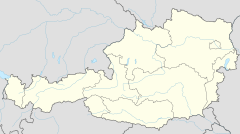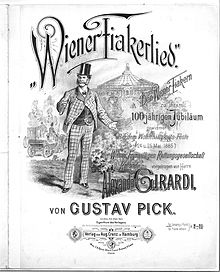This article has multiple issues. Please help improve it or discuss these issues on the talk page. (Learn how and when to remove these messages)
|
| Rotunde | |
|---|---|
 The Rotunde in 1873 The Rotunde in 1873 | |
  | |
| General information | |
| Status | Destroyed by a fire in 1937 |
| Classification | Former building |
| Town or city | Leopoldstadt, Vienna |
| Country | Austria |
| Coordinates | 48°12′44″N 16°24′34″E / 48.21222°N 16.40944°E / 48.21222; 16.40944 |
| Completed | 1873 |
| Dimensions | |
| Diameter | Of dome only: 107.83 m (353.8 ft) (outer) 101.7 m (334 ft) (inner) |
| Circumference | Of dome only: 319.6 m (1,049 ft) (inner) |
| Design and construction | |
| Architect(s) | Baron Karl von Hasenauer |
The Rotunde (German: [roˈtʊndə]) in Vienna's Leopoldstadt district was a building erected for the 1873 Vienna World's Fair (German: Weltausstellung 1873 Wien). The building was a partially covered circular wrought iron construction, 84.1 m (276 ft) tall, with a diameter of 107.83 m (353.8 ft). While the Rotunda stood, its dome was the largest in the world, larger than the Pantheon in Rome. Not until 1957, 20 years after the Rotunda fell, was a larger dome built: the dome of Belgrade Fair – Hall 1, which is only about 1 m (3 ft 3 in) larger in diameter.
The Rotunde was designed by the Austrian architect Baron Karl von Hasenauer, and was built by the German entrepreneur and bridge builder Johann Caspar Harkort VI [de] and his Duisburg-based company. The Scottish civil engineer John Scott Russell was responsible for the dome, which was built with wrought iron.



The German engineer and journalist Wilhelm Heinrich Uhland [de] reported that the Rotunde weighed approximately "80,000 hundredweight (Zoll centner), or about 4000 tons", that is, 4,000,000 kg (8,800,000 lb).
| Conversions of the Rotunde's weight |
|
A centner is a unit of mass equal to 100 of some base unit of mass. The German equivalent of the centner is the Zentner, and its base unit was traditionally the pound (German: Pfund), the definition of which varied in Germany. In 1854 the Zollpfund was defined by the German Customs Union (German: Zollverein) as being equal to 500 grams. The "Zollzentner" or "Zollcentner" is a Zentner/centner with the Zollpfund as its base unit: the Zollzentner is equal to 100 Zollpfund. Accordingly, the weight of the Rotunde reported by Uhland can be converted into metric units:
So, by "4000 tons", Uhland presumably meant 4,000 tonnes/metric tons (SI symbol t), not short or long tons. |
The central building of the World's Fair was accepted enthusiastically by the public. After the World's Fair, the Rotunde was used for shows and fairs.
Alexander Girardi performed in the Rotunde on 24–25 May 1885, singing Gustav Pick's new composition, the Fiakerlied, for the first time.
In 1898, Emperor Franz Joseph's Jubilee Exhibition [de] (German: Jubiläumsausstellung) was held in the Rotunde. The "Collective Exhibition of Austrian Automobile Builders" (German: Collektivausstellung österreichischer Automobilbauer), organized by the Austrian Automobile Club [de] (German: Österreichische Automobil-Club), was held as part of the Jubilee Exhibition. Four automobiles from manufacturers in Austria-Hungary were shown: the automobile built by Siegfried Marcus in 1888–1889 (the first automobile built in Austria-Hungary), an Egger-Lohner [de] electric automobile, an Egger-Lohner petrol automobile, and the Nesselsdorfer Wagenbau-Fabriks-Gesellschaft (now Tatra) Präsident.
The Rotunde burned down in 1937. Its former site is now occupied by buildings associated with the Vienna University of Economics and Business, and with Messe Wien.
Notes
- "Accurately stated, the exterior diameter of the Rotunda is 107·83 meters, and its height 84·1 meters"
- The Pantheon in Rome, which was dedicated c. 126 AD, over 1,700 years before the Rotunde was completed, has a dome that is 43.3 m (142 ft) in diameter
- "The total weight of the structure of the Rotunde may be stated in round numbers at 80,000 hundredweight (Zoll centner), or about 4000 tons"
References
- ^ Uhland, Wilhelm H. (1873) . Written at Leipsic . "Notes on the Vienna Universal exposition". Journal of the Franklin Institute. 95 (3). Philadelphia: Published by the Franklin Institute at their Hall: 185. doi:10.1016/0016-0032(73)90149-x. ISSN 0016-0032. OCLC 1044760573. Retrieved 2023-09-12.
- Bui, Ly Y. (2006-02-23). "The Rotunda of the 1873 Vienna International Exhibition World's Fair Treasury". Retrieved 2023-09-12.
- "Zollgewicht". Meyers Großes Konversations-Lexikon (in German). Vol. 20. Leipzig: Bibliographisches Institut. 1909. p. 982. Retrieved 2023-09-14.
Im Deutschen Zollverein war 1840–71, in Österreich 1852–1875 der Zollzentner = 50 kg, eingeteilt in 100 Zollpfund; die meisten deutschen Staaten nahmen 1858 oder früher das Z. als Landesgewicht an.
- von Hermann, Friedrich Benedikt Wilhelm (1862) . "Appendix, No. 5. : Letter addressed by Mr. Von Hermann to the Chairman.". Eleven Volumes. : —(2.)— : East India Communication; Sydney Branch Mint; Weights and Measures. Reports from Committees. Vol. 7. RA2-PA228. Retrieved 2023-09-14.
In the Zollverein and in Austria the half of the kilogram is in use in the Custom-houses; 100 of such zollpfund are the zollcentners
- Austrian Information Service (1966). "The Prater—Two Centuries of a Vienna Institution". Austrian Information. Vol. XIX. Austrian Information Service. p. 5. ISSN 0005-0520. Retrieved 2023-09-12.
That fabled entertainer Alexander Girardi, would not recognize "his" Prater where he first sang the famous Fiakerlied in the Rotunde in May 1885
- Zapke, Susana; Fichna, Wolfgang (2023). Die Musik des Wiener Praters. Eine liederliche Träumerei: Unbekannte Lieder aus zwei Jahrhunderten (in German). Hollitzer Wissenschaftsverlag. p. 106. ISBN 9783990940891. OCLC 1396220012. Retrieved 2023-09-12.
Gesungen von Alexander Girardi am 25. Mai 1885 in der Rotunde
External links
- Rotunde (in German)



